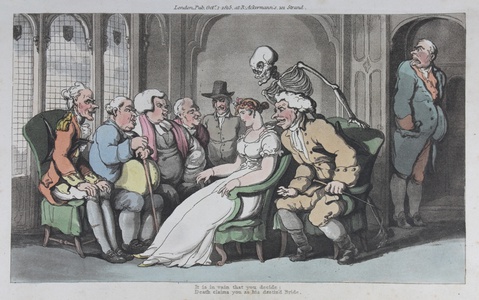| Method | Aquatint with original hand colouring |
| Artist | Thomas Rowlandson |
| Published | London, Pub. Octr. 1. 1815. at R. Ackermann's, 101 Strand. |
| Dimensions | Image 122 x 205 mm, Sheet 142 x 232 mm |
| Notes |
Plate 21 from the second volume of The English Dance of Death, a tragicomic series of plates by Thomas Rowlandson with accompanying rhyming verse by William Combe. The fair Belinda, sole heir to a large fortune, has attracted a suite of suitors: a Colonel, a Lawyer, a Rector, an elderly Baronet, a Quaker, and a Doctor. Belinda is a capricious young woman, and decides the best way to decide on her ideal husband would be to gather the men together and have them present their cases one in front of the other, while her exasperated father lingers by the door. Each has professed his love for her, but all are destined to be shocked when Belinda declares that Love is meaningless to her, and that any man who persists in loving her will never have her for a bride. Each man approaches this statement in his own way, with the Colonel saying that his word is a reflection of his Honour and cannot be renounced, the Lawyer arguing that whether he does or does not Love is irrelevant since the concept is not recognized by law, the Rector claiming that his love is godly and not carnal, and the Baronet promising that he cares not one jot for Love and simply used it as a shorthand for the ribald and liberal life that he intends for them as a couple. The Quaker uses the opportunity to weigh each of his competitors arguments, before essentially removing himself from the contest on the grounds that a marriage without Love would be of no benefit to either, and encourages the Doctor to say his piece. Before the Doctor has begun though, a new suitor appears. Death places a hand on the young lady's shoulder, and the contest is left unresolved. Two lines of rhyming verse below the image read: 'It is in vain that you decide: / Death claims you as his destin'd Bride.' The English Dance of Death was Rowlandson and Combe's comedic English take on the popular danse macabre genre. The medieval danse macabre was at once both ribald and sombre, a subversion of social, politic, and religious hierarchies while at the same time a powerful reminder of the inescapable fate that awaits all mortals. The genre proved popular with printmakers, the most famous of which were undoubtedly those of Hans Holbein the Younger and Wenceslaus Hollar, but none are as satyrical as the English Dance of Death. The dance of death as a theme lent itself perfectly to a farcical excoriation of the foibles of Regency England, and Rowlandson and Combe, who had already established their comedic pedigree by collaborating on the popular Dr Syntax series, were the perfect pair to undertake it. In place of the Popes and paupers, the emperors and merchants, and the nuns and alchemists of the originals, in Rowlandson's plates, we find huntsmen and harlots, debauched nobles and pretentious churchmen, quack doctors and gin-shop wastrels, and a whole host of town and country characters beset by a Death who himself runs the full gamut of human emotion, from malice to exasperation, in the varied pursuit of his English prey. Thomas Rowlandson (1756 - 1827) was an English watercolourist and caricaturist. Born in London, the son of a weaver, Rowlandson studied at the Soho Academy from 1765. On leaving school in 1772, he became a student at the Royal Academy and made the first of many trips to Paris where he may have studied under Jean-Baptiste Pigalle. In 1775 he exhibited the drawing Dalilah Payeth Sampson a Visit while in Prison at Gaza at the Royal Academy and two years later received a silver medal for a bas-relief figure. As a printmaker Rowlandson was largely employed by the art publisher Rudolph Ackermann, who in 1809, issued in his Poetical Magazine The Schoolmaster's Tour, a series of plates with illustrative verses by Dr. William Combe. Proving popular, the plates were engraved again in 1812 by Rowlandson himself, and issued under the title The Tour of Dr Syntax in Search of the Picturesque. By 1813 the series had attained a fifth edition, and was followed in 1820 by Dr Syntax in Search of Consolation, Third Tour of Dr Syntax in Search of a Wife in 1821 and also in the same year by The history of Johnny Quae Genus, the little foundling of the late Doctor Syntax. Rowlandson also illustrated work by Smollett, Goldsmith and Sterne, and for The Spirit of the Public Journals (1825), The English Spy (1825), and The Humorist (1831). William Combe (1742-1823) was an English satirist and hack, best known for his authorship of the Dr Syntax series, which were illustrated with his long time collaborator Thomas Rowlandson. In his early life he travelled extensively, but as a product of his mounting debts, spent most of his later life in the King's Bench Prison. In addition to his work on the Dr Syntax series, he also wrote numerous spurious letter series, including some purporting to be by Lord Lyttleton that were widely considered to be authentic by his peers. In addition to his comedic works, he also produced a number of works of topographical history on London, the Thames, Bristol, and York. Condition: Minor time toning to sheet. Trimmed within platemark, as issued, without loss to image. |
| Framing | unmounted |
| Price | £75.00 |
| Stock ID | 50319 |

